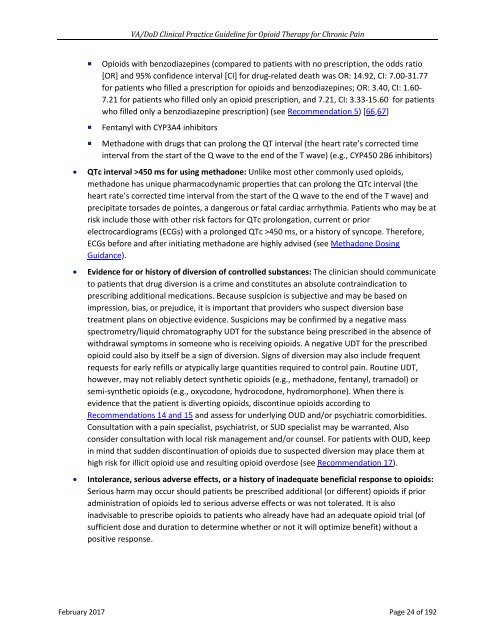VA/DoD CLINICAL PRACTICE GUIDELINE FOR OPIOID THERAPY FOR CHRONIC PAIN
2lfFhbO
2lfFhbO
Create successful ePaper yourself
Turn your PDF publications into a flip-book with our unique Google optimized e-Paper software.
<strong>VA</strong>/<strong>DoD</strong> Clinical Practice Guideline for Opioid Therapy for Chronic Pain<br />
• Opioids with benzodiazepines (compared to patients with no prescription, the odds ratio<br />
[OR] and 95% confidence interval [CI] for drug-related death was OR: 14.92, CI: 7.00-31.77<br />
for patients who filled a prescription for opioids and benzodiazepines; OR: 3.40, CI: 1.60-<br />
7.21 for patients who filled only an opioid prescription, and 7.21, CI: 3.33-15.60 for patients<br />
who filled only a benzodiazepine prescription) (see Recommendation 5) [66,67]<br />
• Fentanyl with CYP3A4 inhibitors<br />
• Methadone with drugs that can prolong the QT interval (the heart rate’s corrected time<br />
interval from the start of the Q wave to the end of the T wave) (e.g., CYP450 2B6 inhibitors)<br />
• QTc interval >450 ms for using methadone: Unlike most other commonly used opioids,<br />
methadone has unique pharmacodynamic properties that can prolong the QTc interval (the<br />
heart rate’s corrected time interval from the start of the Q wave to the end of the T wave) and<br />
precipitate torsades de pointes, a dangerous or fatal cardiac arrhythmia. Patients who may be at<br />
risk include those with other risk factors for QTc prolongation, current or prior<br />
electrocardiograms (ECGs) with a prolonged QTc >450 ms, or a history of syncope. Therefore,<br />
ECGs before and after initiating methadone are highly advised (see Methadone Dosing<br />
Guidance).<br />
• Evidence for or history of diversion of controlled substances: The clinician should communicate<br />
to patients that drug diversion is a crime and constitutes an absolute contraindication to<br />
prescribing additional medications. Because suspicion is subjective and may be based on<br />
impression, bias, or prejudice, it is important that providers who suspect diversion base<br />
treatment plans on objective evidence. Suspicions may be confirmed by a negative mass<br />
spectrometry/liquid chromatography UDT for the substance being prescribed in the absence of<br />
withdrawal symptoms in someone who is receiving opioids. A negative UDT for the prescribed<br />
opioid could also by itself be a sign of diversion. Signs of diversion may also include frequent<br />
requests for early refills or atypically large quantities required to control pain. Routine UDT,<br />
however, may not reliably detect synthetic opioids (e.g., methadone, fentanyl, tramadol) or<br />
semi-synthetic opioids (e.g., oxycodone, hydrocodone, hydromorphone). When there is<br />
evidence that the patient is diverting opioids, discontinue opioids according to<br />
Recommendations 14 and 15 and assess for underlying OUD and/or psychiatric comorbidities.<br />
Consultation with a pain specialist, psychiatrist, or SUD specialist may be warranted. Also<br />
consider consultation with local risk management and/or counsel. For patients with OUD, keep<br />
in mind that sudden discontinuation of opioids due to suspected diversion may place them at<br />
high risk for illicit opioid use and resulting opioid overdose (see Recommendation 17).<br />
• Intolerance, serious adverse effects, or a history of inadequate beneficial response to opioids:<br />
Serious harm may occur should patients be prescribed additional (or different) opioids if prior<br />
administration of opioids led to serious adverse effects or was not tolerated. It is also<br />
inadvisable to prescribe opioids to patients who already have had an adequate opioid trial (of<br />
sufficient dose and duration to determine whether or not it will optimize benefit) without a<br />
positive response.<br />
February 2017 Page 24 of 192


